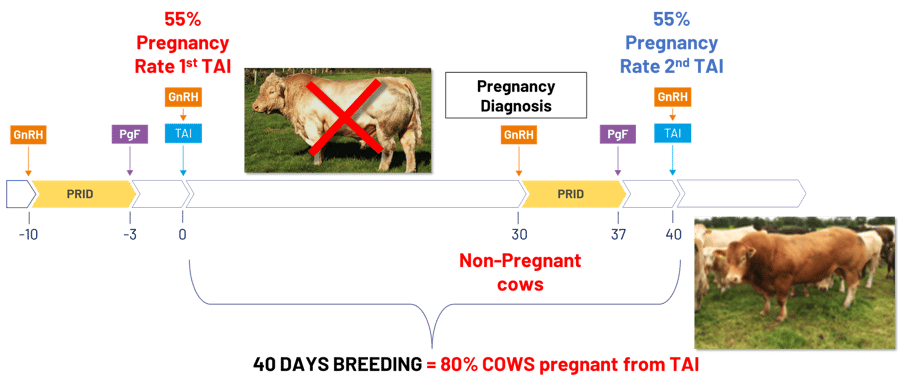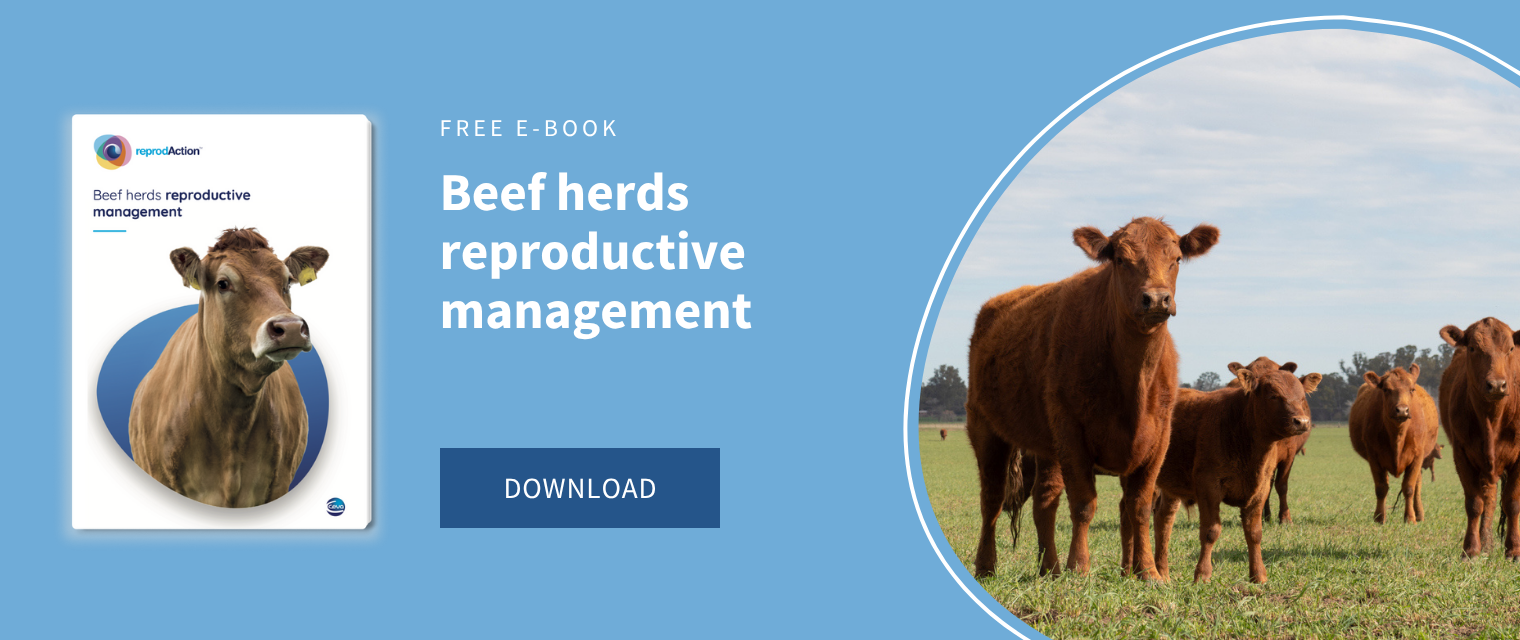The worldwide use of frozen semen has risen in recent decades. In Latin America, and Brazil in particular, the use of frozen semen in cow/calf operations has dramatically increased by 630% in the last 12 years. The extremely extensive production conditions of Latin American countries do not facilitate the practice of oestrus detection, so practically all cows are inseminated on the basis of oestrus synchronization programs for Timed Artificial Insemination (TAI). These chronologically planned fertility schemes allow producers to submit cows at a pre-determined time, enabling 100% submission and the planning of the breeding period in accordance with other activities.
Synchronization programs for TAI can greatly impact the economic viability of cow-calf operations by enhancing weaning weights and increasing the chances that a cow weans a calf at the end of the subsequent calving season. The second greatest potential for these programs is the ability to compact the calving season, reducing the interval from calving to conception and the calving spread, and optimizing the labour required for this activity.
The use of synchronization programs for beef cows at the initiation of the breeding season, in combination with the use of stock-bulls later in the season, results in the most efficient way to manage reproduction in extensive beef herds.
Several synchronization options have been designed in the last 20 years, since the development of the so-called ‘Ovsynch’ protocol for oestrous synchronization and insemination at a pre-determined time. Some of the initial programs on beef cows failed to address the primary physiological obstacles that beef producers face in breeding suckled cows and maiden beef heifers, the need to overcome post-partum anoestrous and the peripubertal period. The unsatisfactory results initially achieved have compromised the widespread adoption of these programs, leaving some cattle practitioners reluctant today to promote their usage at the farm level.
The most important points to consider in the design of beef cow synchronization protocols
- the reduction of the number and frequency of animal handlings, with a maximum of 3 handlings including insemination
- the elimination of the need to detect oestrus
- the use of protocols capable of inducing ovulation in anoestrous post-partum suckled cows
Due to the physiology of the post-partum suckled cow, 50% of the herd will not have ovulated and resumed normal cyclicity before the start of the breeding season. For this reason, oestrous synchronization programs now include a progesterone releasing intravaginal device (PRID) which has the ability to restart LH pulse frequency suppressed by the cow-calf bond, allowing induction of ovulation in both non-cyclic and cyclic cows.
In order to obtain accurate and robust information on the potential for TAI in beef cow herds, as well as to compare currently available protocols, recently we conducted a series of large scale on-farm synchronization studies involving 74 beef cow herds in Ireland. The trials were run in both autumn and spring calving herds with a total of 2,200 cows (calved ≥35days). Three different synchronization protocols were compared: all cows were subjected to a single TAI at 72 hours after PRID® Delta removal. Pregnancy rates between treatments ranged from 50-70%, with a very positive overall average pregnancy rate of 55% achieved with a single timed insemination the protocol (Figure 1).
 Figure 1: Diagram illustrating the synchronization program utilised during the on farms trial performed by Teagasc and UCD in Ireland, GnRH = (2 ml of Ovarelin®, 100 μg of gonadorelin diacetate tetrahydrate, Ceva Sante Animale, Libourne France), PgF = (5 ml of Enzaprost®, 25 mg of dinoprost trometamol, Ceva Sante Animale), eCG = (400 IU eCG, Syncrostim®, Ceva Sante Animale), PRID = (1 PRID® Delta, 1.55g progesterone release intravaginal device)
Figure 1: Diagram illustrating the synchronization program utilised during the on farms trial performed by Teagasc and UCD in Ireland, GnRH = (2 ml of Ovarelin®, 100 μg of gonadorelin diacetate tetrahydrate, Ceva Sante Animale, Libourne France), PgF = (5 ml of Enzaprost®, 25 mg of dinoprost trometamol, Ceva Sante Animale), eCG = (400 IU eCG, Syncrostim®, Ceva Sante Animale), PRID = (1 PRID® Delta, 1.55g progesterone release intravaginal device)
Average conception rates were varying between 52% for the treatment lacking GnRH at PRID insertion (number of cows per treatment =459), 56% for the treatment that included GnRH at PRID insertion (n=484 cows); the supplementation of eCG at the time of PRID removal brought the pregnancy/AI to 58% (n=467 cows) (Figure 1).
Very importantly, synchronization has the effect of tightening up the calving pattern and enhances the resumption of cyclicity in the following season. For example, in the mentioned trial, 78% of all synchronised cows were pregnant within 23 days from the start of the breeding season: 55% to TAI plus a further 48% of the cows that initially did not conceive with the TAI became pregnant in the first repeat cycle.
How can we boost the number of calves born from Synchronization protocols of beef cows?
The application of proactive reproductive management strategies should be considered for specific beef herds interested in the maximization of genetic gain through AI. One such strategy should focus on inseminating all the cows at the beginning of the breeding season, identifying non-pregnant cows as soon as possible, and rebreeding them with the use of synchronization for TAI. Re-synch programs, which are quite popular in dairy operations, are not that common in beef herds. For this reason, protocols have been designed on the basis of a pregnancy diagnosis performed at 30 days post TAI and rebreeding with TAI, at day 40, for all non-pregnant cows. This strategy can potentially be repeated multiple times to maximise the number of offspring from AI in one given herd (Figure 2).

Figure 2: Strategic application of re-synchronization strategy in beef cow herds and achievable results
Such re-synchronization programs may be perceived as very expensive breeding solutions by beef farmers. However, these schemes can reduce the number of stock-bulls required per herd, as summarized in Table 1, because a significant proportion of cows conceive to AI. Furthermore, stock-bulls are very expensive elements of cow-calf operations, both in terms of purchase as well as maintenance.
| Reproductive Management |
Number of AI |
Pregnant per AI |
Number of bulls |
AI Breeding Period |
| 1 FTAI + Bull |
100 |
50 |
4 |
|
| 2 FTAI + Bull |
150 |
75 |
2 |
40 Days |
| 3 FTAI |
175 |
87 |
0/1 |
80 Days |
Table 1: Summary of the numbers of AI to be performed, number of pregnancies derived from AI, and total number of bulls necessary with different re-synchronization strategies.
Final remarks
It is strongly recommended that beef farmers should develop a specific breeding programme to produce high quality stock. Given the challenges associated with achieving a high submission rate through heat detection, the use of a PRID synchronization protocol combined with fixed time AI is an extremely valuable tool. This strategy allows 100% submission on the appointed breeding date, a pregnancy rate of about 55% in inseminated cows, synchronous returns to heat in those cows that do not get pregnant to the first AI and two compact calving periods the following season, which facilitates labour management on the farm. Stock-bulls will very likely remain an important component of the cow-calf operation, and for this reason attention should be given to their health and fertility, for herds willing to maximise the number of calves born from AI, re-Synchronization programs can be adopted after early pregnancy diagnosis.
About the author
Federico Randi (Ruminants Global Technical Manager)
Federico Randi is Global Technical Manager for Ruminants at Ceva Animal Health, specializing in cattle reproduction. With a Doctor of Veterinary Medicine degree “cum laude” from the University of Bologna, he focused his career on improving efficiency and sustainability of farmed animals. Randi conducts research on ruminants fertility, using technologies like Timed AI, embryo transfer, and recombinant technologies. His extensive experience includes collaborative projects with over 20 research institutions globally. He earned his PhD at University College Dublin, concentrating on fixed-time artificial insemination and embryonic maternal communication in cattle. Currently, he serves as a Board Member in the Scientific Commission of Animal Physiology for the European Federation of Animal Science (EAAP) as an Industry Representative.

.jpg)


Leave your comments here